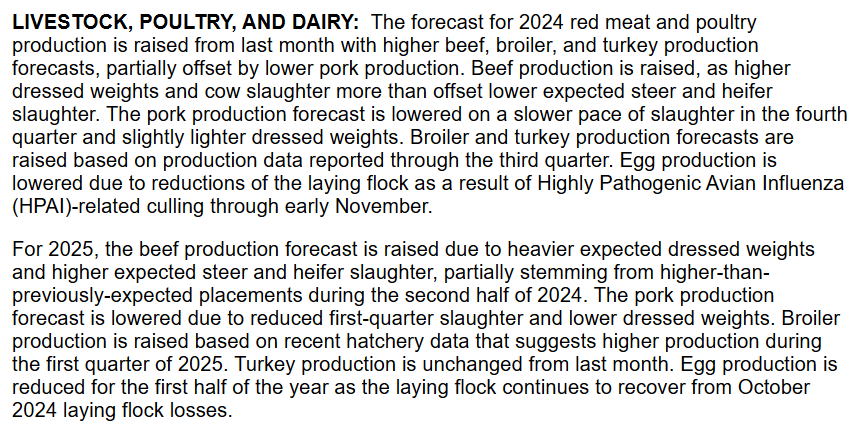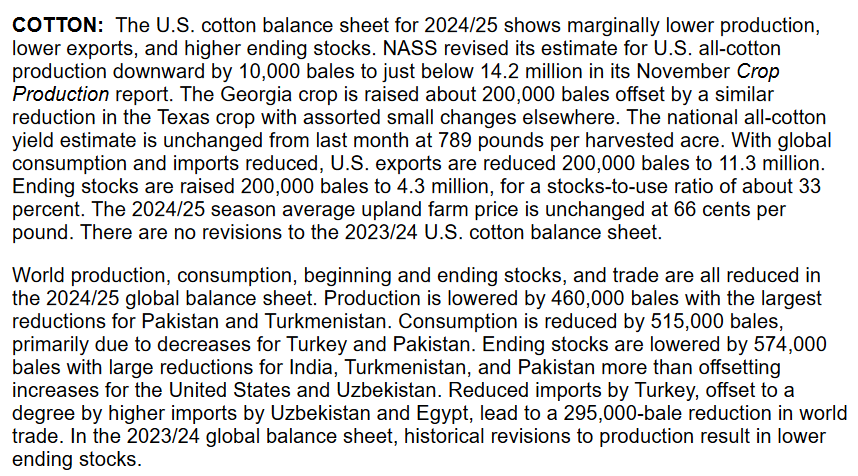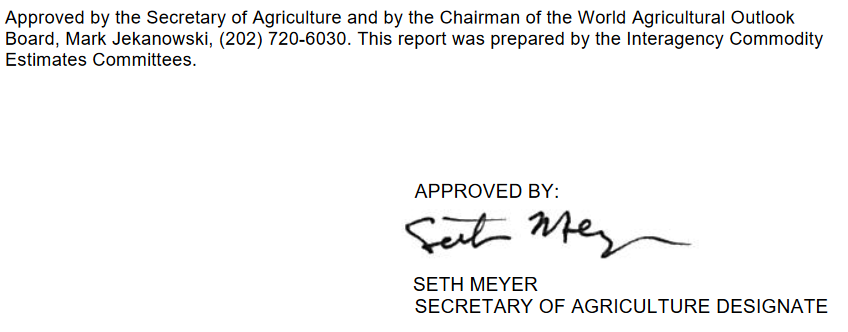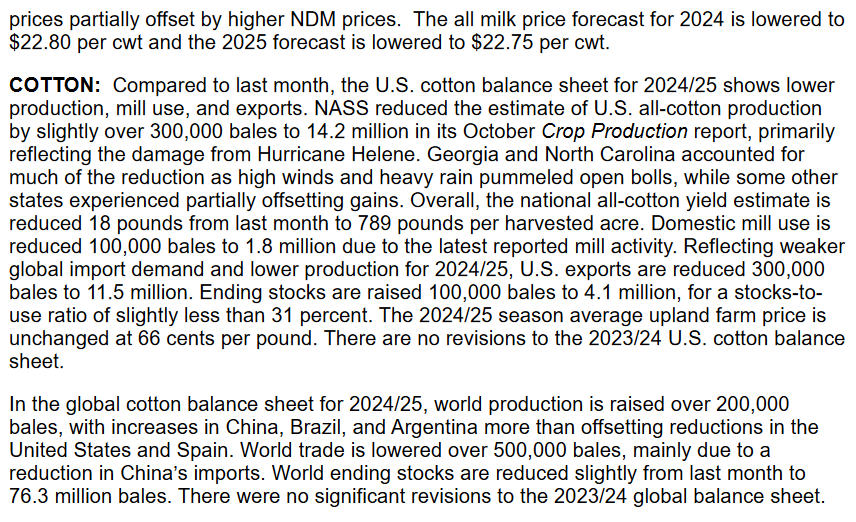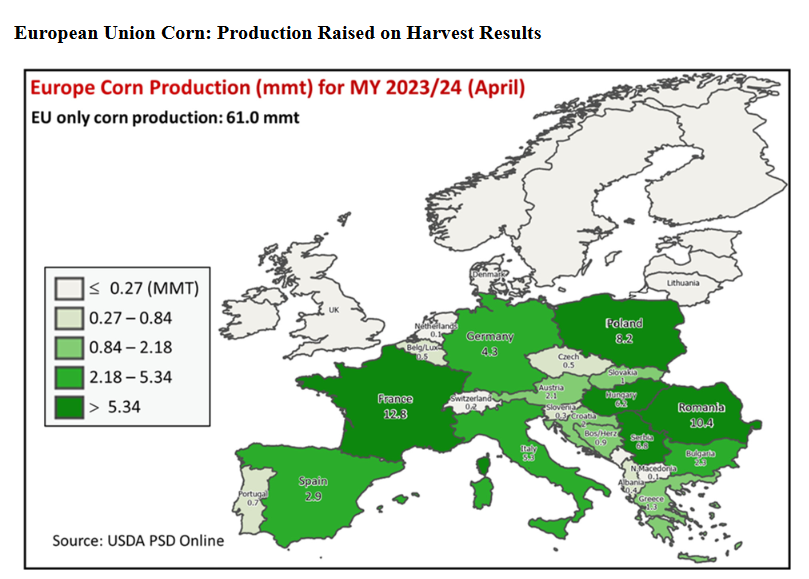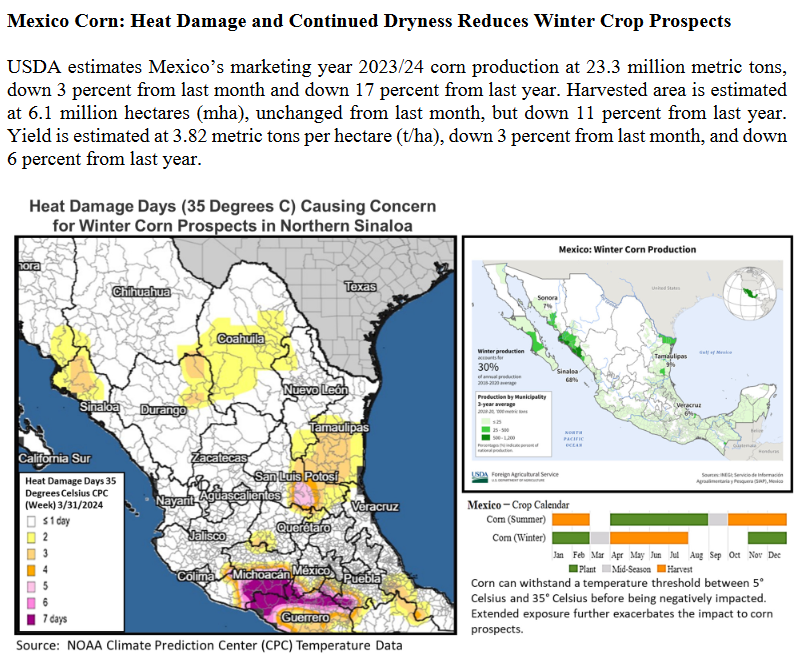U.S. Agriculture News – Published September 28, 2024
We recently reported on World Agriculture Production and our report can be accessed HERE.
That report included the U.S. but here we focus on the U.S.

| This is a simple table but you can see that the index of prices received were higher in August 2024 than July 2024 or August 2023. Similarly, the index of prices paid by farmers and ranchers was lower in August of 2024 so presumably, profit increased. |
Some will have to click on “Read More” to access the full article.
World Agriculture Production, Supply, and Demand as provided by USDA in their September Report which I am publishing on September 26, 2024


We start with the Supply and Demand Estimates which is an all-text discussion.
Then we look at World Agriculture Production and here there are many interesting maps and graphs. Production is part of Supply but Supply also includes the starting inventory and the ending inventory among other adjustments. So the two reports go together and I am presenting them that way.
There is so much here that I did not think that me adding comments would be helpful so I have refrained from doing that.
Some will need to click on “Read More to read the full article.
WASDE – World Agricultural Supply and Demand Estimates – July 12, 2024 – Posted on July 27, 2024

Once a month USDA issues two reports on World Agriculture: One on Supply and Demand and one on Production. USDA does not make it easy to find these reports. It is probably because they are produced by two different parts of USDA and the arrangement may change a bit from time to time.
I do not publish this article every month since it is difficult to prepare but this is a time of the year when the information is very relevant and important in terms of:
A. How production may have been impacted by El Nino which is wet for the U.S. but dry for many parts of the World.
B. How Supply and Demand might be impacted by Global Warming and
C. The impact from and on the World GeoPolitical situation.

In this article, I am presenting the summary of the World Supply and Demand Estimates. In a few days, I may publish an article on production which is a component of Supply. Supply takes into account changes in inventory. It is like the difference between a P&L and a balance sheet or as economists express it flows and stocks. People who rely on these reports understand the nuances. In this article, I am simply providing the summary of the WASDE report for July of this year.
Some will need to click on “Read More” to access the full article.
World Agriculture Production – El Nino Impacts Discussed – April 15, 2024

Once a month USDA issues two reports on World Agriculture Production. Saturday I published the summary of the World Agriculture Supply and Demand (WASDE) situation. My article on this can be accessed HERE. The USDA report on supply and demand includes information on production but does not provide as much information on production as this report but the production information in this USDA Report is is taken from the USDA report on Supply and Demand. Production is part of Supply because Supply is current Production plus changes in inventory. It is confusing with two parts of USDA publishing information on the same topic but you need to look at both reports to get the complete picture.
Production is useful when we are looking at trends. That information is provided in this USDA Report and I am providing the part of the report that contains maps and text.The second part of the report contains detailed tables covering a large number of nations and crops. At the end of the article I provide the link to the full report. I think that each month USDA focuses on certain countries and crops. If they did that each month their report would be way too large and they probably do not have the staff to create that kind of report each month.
Remember: The U.S. is part of the World so reports about World Production also contain information on U.S. Production. All of these reports are complicated by the time of the year the report is produced. The stage of production varies a lot from the Northern Hemisphere to the Southern Hemisphere and also by crop and species of animal. I have reorganized the report a bit to keep all the information for the same country together and to start with the EU as I thought that would be of most interest to readers.
There is also a U.S. version of this report but there are only so many hours in the day for me to write and readers to read my articles.
The Production report is useful for understanding of:
A. How it might be impacted by Global Warming and
B. The impact on the World Geo-political situation.
C. The impact of ENSO. For the U.S. El Nino tends to be wet. For much of the World, El Nino tends to be dry. So we see both impacts in what I will now present.
Let’s get started. Where I have comments the are provided in a box so that you can tell that is from USDA and what are my mostly explanatory comments. At the end of the article there is a conversion table from metric to English Units e.g. hectares versus acres.
| It is easy to get confused with what is being presented in the above graphics. In some cases they are talking about yield. In other cases the number of Hectares planted. I think the abbreviation MY means market year which varies by crop and location. Also the maps show the EU so they do not include the UK or Ukraine. |
| NDVI (Normalized Difference Vegetation Index) is used to quantify vegetation greenness and is useful in understanding vegetation density and assessing changes in plant health. NDVI is calculated as a ratio between the red (R) and near infrared (NIR) values in traditional fashion: (NIR – R) / (NIR + R). The NDVI does not show the cause of something but the result of something. One can surmise that it was wet in Nov – Dec which was good for plant growth and then dry through to March. I am not exactly sure why USDA included that graphic but it is a common measure so I thought I would explain it. |
Some will have to click on “Read More” to access the remainder of this article. There is a lot more.
WASDE – World Agricultural Supply and Demand Estimates – April 13, 2024.

Once a month USDA issues two reports on World Agriculture: One on Supply and Demand and one on Production. USDA does not make it easy to find these reports. It is probably because they are produced by two different parts of USDA and the arrangement may change a bit from time to time.
I do not publish this article every month since it is difficult to prepare but this is a time of the year when the information is very relevant and important in terms of:
A. How production may have been impacted by El Nino which is wet for the U.S. but dry for many parts of the World.
B. How Supply and Demand might be impacted by Global Warming and
C. The impact from and on the World GeoPolitical situation.

In this article, I am presenting the summary of the World Supply and Demand Estimates. In a few days, I will publish an article on production which is a component of Supply. Supply takes into account changes in inventory. It is like the difference between a P&L and a balance sheet or as economists express it flows and stocks. People who rely on these reports understand the nuances. In this article, I am simply providing the summary of the WASDE report for April of this year.
Some will need to click on “Read More” to access the full article.
Agriculture Prices January 6, 2024: 2003 Has Not Been a Good Year in Most Cases
Updated at 1:20 a.m. January 7, 2024 to do some light editing and add the discussion of price parity.

| In theory, if the prices received decline by 15% and your prices paid decline by 0.3% you should be in trouble. Let’s take a closer look. Some readers will have to click on “Read More to access the full article. I have included most of the report but the full report can be accessed HERE. In most cases, we are looking at Nov 2023 as compared to either the prior month i.e. October 2023 or the same month last year which would be November 2022. So in many cases, it is a November to November comparison but if you look closely it is pretty much a comparison of 2023 to 2022. The section I left out is called Price Parity. I left it out mostly because I do not understand it. I think it is less important now than in the past but you be the judge by reading HERE. |

Crop Report of Progress and Production Estimates November 18, 2023
Record High Corn Forecast
This article is based primarily on two sets of information:
A. The Crop Bulletin that was issued on November 14, 2023, and
B. Crop Production Executive Summary issued on November 9, 2023. We only used a limited number of graphics from this long presentation…different graphics than we used last month. We provide a link to the full report. For the three main crops the NASS forecasts are higher than many of the industry forecasts so we will see if NASS has it right or if NASS is being overly optimistic.
We are coming to the end of this growing season so we are including both the progress of crops and the estimates of the final production hence the use of the two reports.
This article includes a short international review of agricultural conditions which are generally favorable. I also included U.S. crop-related weather forecasts.
We first look at the National Agriculture Summary. The Tables below the summary have additional data.

| Below is pretty much the same information in table format. However, there is a lot of additional information in these tables. |


Some additional detail is provided HEREIt is mostly some additional weeks of data and it is all in larger print. |
















